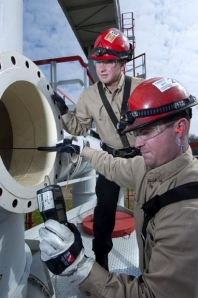 Introduction: According to the Chemical Safety Board “Contractor Safety Digest,” the agency has conducted several fatal investigations where insufficient safety requirements for contractor selection and oversight were found to be causal to the incidents.
Introduction: According to the Chemical Safety Board “Contractor Safety Digest,” the agency has conducted several fatal investigations where insufficient safety requirements for contractor selection and oversight were found to be causal to the incidents. • Requiring a comprehensive review and evaluation of contractor safety policies and safety performance of contractors working in confined spaces.
 That old adage “You get what you pay for,” holds a lot of truth in so many instances, and especially so with contractors. Now I am not saying that you will never get high quality at a low price, but it is rare. When you put a job out for bid, it is important to list the specifications for the work or product that you need the bidders to meet, but equally as important is to list other specifications besides the job or product scope, and one of these specifications is safety.
That old adage “You get what you pay for,” holds a lot of truth in so many instances, and especially so with contractors. Now I am not saying that you will never get high quality at a low price, but it is rare. When you put a job out for bid, it is important to list the specifications for the work or product that you need the bidders to meet, but equally as important is to list other specifications besides the job or product scope, and one of these specifications is safety. A hiring client can rely on the various sites to set default requirements for the type of work they need and the associated criteria that must be met, or the hiring client can modify or specify custom needs that must be met. The scoring for potential contractors typically is graded on some sort of easy to view scale such as green-meets all requirements, yellow-meets most requirements but falls short on one or more non-critical criteria, or red-fails to meet basic or critical criteria. Some score it like school grades A, B, C, D, F.
A hiring client can rely on the various sites to set default requirements for the type of work they need and the associated criteria that must be met, or the hiring client can modify or specify custom needs that must be met. The scoring for potential contractors typically is graded on some sort of easy to view scale such as green-meets all requirements, yellow-meets most requirements but falls short on one or more non-critical criteria, or red-fails to meet basic or critical criteria. Some score it like school grades A, B, C, D, F. The advantage of these types of contractor management compliance vetting sites is they have access to a huge database of potential contractors and provide a quick and easy platform for narrowing the field. Of course, once a hiring client has narrowed the field down to a manageable level, it is always prudent to perform a more targeted interview of a potential contractor – and, focusing on safety, is one of the most important considerations!
 Well, there is another old adage that goes like this “Who pays the piper, calls the tune.” Once you have engaged with a contractor, it is imperative that they understand your expectations regarding safety and accept that as part of the job performance. This is the time to ensure that not only legislated safety requirements are met, but also any hiring client safety policies that may exceed OSHA are also explained and understood.
Well, there is another old adage that goes like this “Who pays the piper, calls the tune.” Once you have engaged with a contractor, it is imperative that they understand your expectations regarding safety and accept that as part of the job performance. This is the time to ensure that not only legislated safety requirements are met, but also any hiring client safety policies that may exceed OSHA are also explained and understood.


.jpg) We all want to succeed, no matter what we are doing. And success is always better than the alternatives…whether a mediocre performance or worse yet, failure.
We all want to succeed, no matter what we are doing. And success is always better than the alternatives…whether a mediocre performance or worse yet, failure.
 Does your company authorize employees to work at height using personal fall arrest systems (PFAS)?
Does your company authorize employees to work at height using personal fall arrest systems (PFAS)?
 So, if your facility seems to be behind the curve regarding the rescue of workers from height, you may need to discuss training options - either for the worker that has fallen and remains suspended from their PFAS, or for the one who is injured or ill at height with no way to get down.
So, if your facility seems to be behind the curve regarding the rescue of workers from height, you may need to discuss training options - either for the worker that has fallen and remains suspended from their PFAS, or for the one who is injured or ill at height with no way to get down. By Pat Furr, Safety Officer & VPP Coordinator for Roco Rescue, Inc.
By Pat Furr, Safety Officer & VPP Coordinator for Roco Rescue, Inc. Whenever we tie a knot in a line we lose some of the efficiency in the rope or webbing we are using. Generally, the more acute the first bend in the knot, the more efficiency is lost.
Whenever we tie a knot in a line we lose some of the efficiency in the rope or webbing we are using. Generally, the more acute the first bend in the knot, the more efficiency is lost.

 Oxygen-Depleted Atmospheric Hazards in Confined Spaces
Oxygen-Depleted Atmospheric Hazards in Confined Spaces My experiences in the altitude chamber were educational and potentially lifesaving if I were ever exposed to a low oxygen environment. By having experienced my subtle symptoms multiple times, perhaps I would recognize them in a lower than normal oxygen environment and be able to take action to rescue myself. However, the environment that I was exposed to was probably in the range of 12% oxygen by volume give or take. In lower concentrations, say below 10%, the onset of impaired judgment would be so rapid that I would have little chance to recognize and react on my own behalf. In extremely low concentrations of 0-8%, there is little chance for anyone to take self-rescue actions. More than likely, the individual will pass out after only one or two gasping breaths. And, most importantly, my experiences were in a controlled environment with highly trained observers and emergency personnel standing by. This is not always the case during confined space entry operations.
My experiences in the altitude chamber were educational and potentially lifesaving if I were ever exposed to a low oxygen environment. By having experienced my subtle symptoms multiple times, perhaps I would recognize them in a lower than normal oxygen environment and be able to take action to rescue myself. However, the environment that I was exposed to was probably in the range of 12% oxygen by volume give or take. In lower concentrations, say below 10%, the onset of impaired judgment would be so rapid that I would have little chance to recognize and react on my own behalf. In extremely low concentrations of 0-8%, there is little chance for anyone to take self-rescue actions. More than likely, the individual will pass out after only one or two gasping breaths. And, most importantly, my experiences were in a controlled environment with highly trained observers and emergency personnel standing by. This is not always the case during confined space entry operations.




